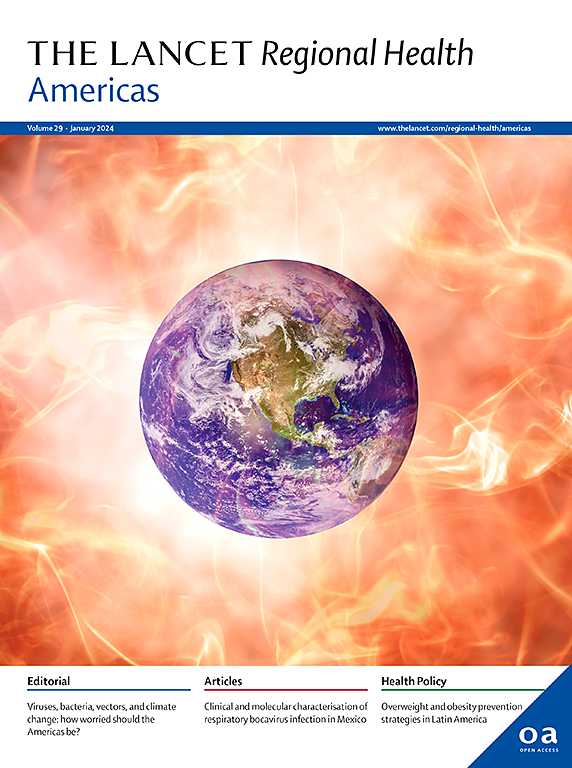2024年玻利维亚Oropouche病毒的基因组特征、起源和本地传播
IF 7
Q1 HEALTH CARE SCIENCES & SERVICES
引用次数: 0
摘要
Oropouche病毒(OROV)是一种节肢动物传播的病毒,与其他虫媒病毒性疾病一样,可引起急性发热性疾病。2024年,包括玻利维亚在内的几个美洲国家的Oropouche病例急剧增加。在这里,我们调查了OROV在玻利维亚亚马逊地区的起源和传播。方法采用基于扩增子的方法对2024年玻利维亚三个疫区采集的34份阳性样本进行OROV全基因组测序。对不同病毒片段进行了最大似然(ML)系统发育分析,以确定负责的病毒谱系。利用贝叶斯系统地理分析方法重建了病毒在全国范围内的时空分布格局。1月中旬从潘多省收集的样本报告了玻利维亚2024年的第一例Oropouche病例,Oropouche病例的高峰发生在4月中旬。对OROV基因组的系统发育分析显示,在玻利维亚发现的所有病例都属于导致最近在巴西流行的新型重组OROV分支。我们的系统地理学分析发现,至少有两次从巴西阿克里州向玻利维亚的Guayaramerín和里伯拉尔塔市出口的事件,这两个地区都位于贝尼省,随后传播到潘多省和拉巴斯省。病毒引入可能发生在2023年10月初至11月初之间,这表明在引入OROV和检测到OROV之间大约有三个月的滞后。我们的研究结果证实,OROV在2023年底至少两次从巴西亚马逊西部传播到邻近的玻利维亚贝尼省,成功地建立了区域传播链。这些发现强调了在巴西和玻利维亚之间的亚马逊边境地区积极监测OROV的迫切需要。它们还证实了OROV在玻利维亚亚马逊地区持续传播的可能性,突出了为未来疫情做好准备的重要性。本出版物得到了泛美卫生组织合作协议编号NU50CK000639的部分支持,由疾病控制和预防中心提供资金。本文章由计算机程序翻译,如有差异,请以英文原文为准。
Genomic characterization, origin, and local transmission of Oropouche virus in Bolivia in 2024
Background
The Oropouche virus (OROV) is an arthropod-borne virus that causes an acute febrile illness, like other arboviral diseases. In 2024, Oropouche cases sharply increased in several countries of the Americas, including Bolivia. Here, we investigate the origin and spread of OROV in the Bolivian Amazon region.
Methods
Full-length OROV genomes from 34 positive samples collected in the three affected Bolivian departments during the 2024 outbreak were sequenced using an amplicon-based approach. Maximum Likelihood (ML) phylogenetic analyses of separate viral segments were conducted to identify the responsible viral lineage. Bayesian phylogeographic analysis of concatenated viral segments was used to reconstruct the viral spatiotemporal dispersion pattern within the country.
Findings
The first Oropouche cases in Bolivia 2024 were reported using samples collected from the Pando department during mid-January, and the peak of Oropouche cases occurred in mid-April. The phylogenetic analysis of OROV genomes revealed that all cases detected in Bolivia belong to the novel reassortant OROV clade that drove the recent epidemic in Brazil. Our phylogeographic analysis detected at least two exportation events from the Brazilian state of Acre to the Bolivian municipalities of Guayaramerín and Riberalta, both located in the Beni department, with subsequent dissemination to municipalities of Pando and La Paz departments. Viral introductions likely occurred between early October and early November 2023, indicating a lag of approximately three months between the introduction of OROV and its detection.
Interpretation
Our findings confirm that OROV spread at least twice from the western Brazilian Amazon to the neighboring Bolivian department of Beni in late 2023, successfully establishing regional transmission chains. These findings underscore the critical need for active OROV surveillance across the border Amazonian region between Brazil and Bolivia. They also confirm the potential for sustained OROV transmission within the Bolivian Amazon, highlighting the importance of preparedness for future outbreaks.
Funding
This publication was in part supported by the Cooperative Agreement Number NU50CK000639 awarded to the Pan American Health Organization and funded by the Centers for Disease Control and Prevention.
求助全文
通过发布文献求助,成功后即可免费获取论文全文。
去求助
来源期刊

Lancet Regional Health-Americas
Multiple-
CiteScore
8.00
自引率
0.00%
发文量
0
期刊介绍:
The Lancet Regional Health – Americas, an open-access journal, contributes to The Lancet's global initiative by focusing on health-care quality and access in the Americas. It aims to advance clinical practice and health policy in the region, promoting better health outcomes. The journal publishes high-quality original research advocating change or shedding light on clinical practice and health policy. It welcomes submissions on various regional health topics, including infectious diseases, non-communicable diseases, child and adolescent health, maternal and reproductive health, emergency care, health policy, and health equity.
 求助内容:
求助内容: 应助结果提醒方式:
应助结果提醒方式:


